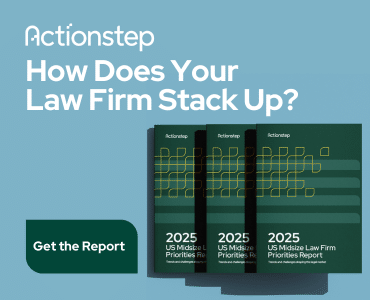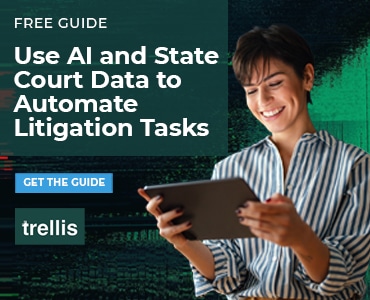The clock is ticking for law firms without a coherent AI adoption strategy. “This transformation is happening now.”

Table of contents
The Thomson Reuters 2025 Future of Professionals Report, released today, is a wake-up call for law firms on the trailing edge of artificial intelligence adoption. Based on input from 2,275 global professionals, the 2025 report details the state of AI adoption in legal, tax, trade, accounting, and risk and compliance organizations—and offers insights on the best paths forward for modern professionals and their firms.
The Stark Competitive Divide
According to the report, the most significant finding in this year’s data is the new and expanding divide between organizations that have an AI strategy and those that do not. Organizations with clear AI strategies linked to their overall goals are twice as likely as those with more informal or ad hoc approaches to see revenue growth as a result of AI adoption, and 3.5 times more likely to experience critical AI benefits.
The same is true when looking only at the law firm data. “There is a stark competitive divide amongst law firms when it comes to AI, and those without a plan for AI adoption, which is nearly one-third, put themselves at risk of falling behind as competitors transform their operations,” saysRaghu Ramanathan, president of Legal Professionals, Thomson Reuters. “Law firms that have an AI strategy are 3.9 times more likely to see benefits from AI compared to firms with no plans for AI adoption and nearly twice as likely to experience revenue growth compared to firms adopting AI without a strategic approach.
“This isn’t a topic for your partner retreat in six months,” he adds. “This transformation is happening now.”
The $32 Billion Value Opportunity
The report reveals a significant disparity in AI adoption, with some organizations experiencing significant benefits while others struggle to implement AI effectively.
When asked to look ahead to the next year and beyond, approximately half of the professionals surveyed said they’re either already seeing the benefits of their organizations’ AI investment in their daily work, or are expecting to see those benefits within the next 12 months. As for those benefits, survey respondents across industries predict that professionals using AI will save 5 hours weekly within the next year, up from 4 hours predicted in 2024.
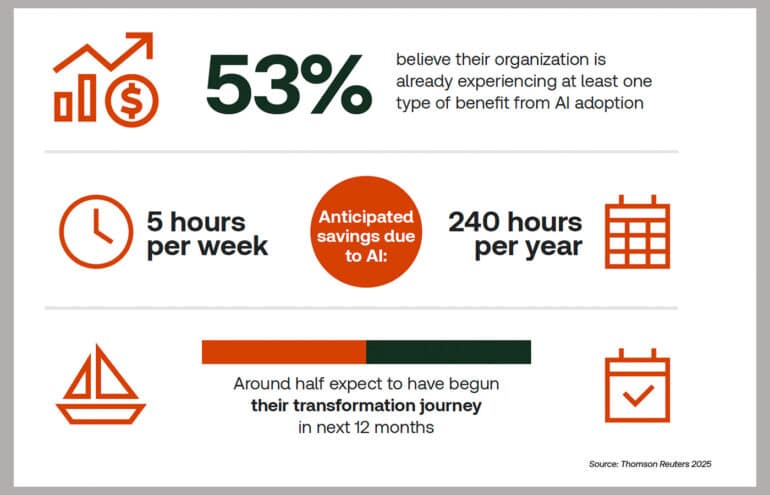
According to the study’s overall findings, this will unlock an average of $19,000 in annual value per person. In the U.S. alone, this AI-driven efficiency could translate to a $32 billion combined annual impact for the legal and CPA sectors.
“Professional work is now being shaped by AI, and those who fail to adapt risk being left behind,” says Steve Hasker, President and CEO of Thomson Reuters. “The $32 billion value opportunity in the U.S. is a wake-up call for organizations to prioritize strategic AI adoption and investment.
The Jagged Edge of AI Adoption
While 80% of law firm professionals believe AI will transform or have a high impact on their work, only 29% expect high levels of change at their firm this year, says Ramanathan. “This disconnect sends a clear message: access to the latest technology does not automatically mean value creation for law firms. In this era of transformation, having enthusiasm for AI is not enough. Lawyers now understand that AI adoption is harder than initially anticipated, and law firms have struggled to fundamentally re-engineer their processes and workflows to incorporate AI.”
According to the report, 81% of firms with a strategy are already seeing ROI from AI, compared to 64% of firms adopting AI without a strategy and 23% of firms with zero strategy.
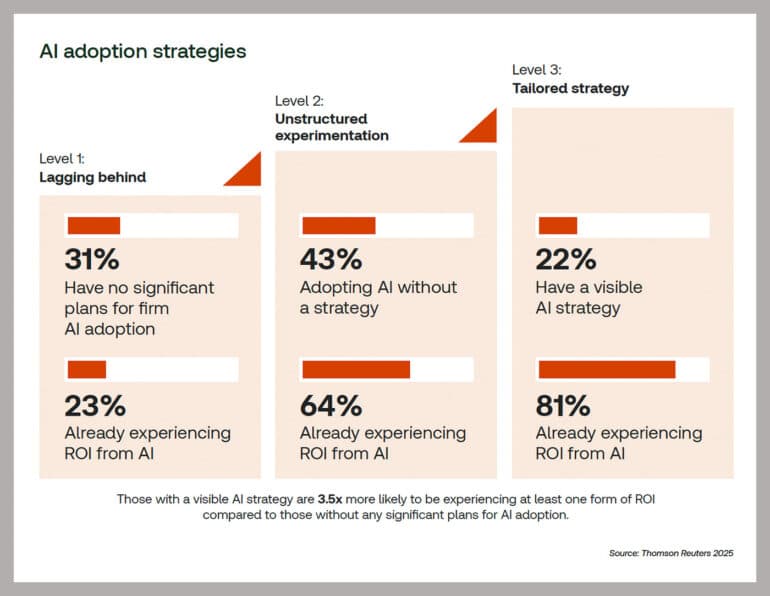
AI Adoption Over the Next Three Years Will Be Telling
When discussing the pace of AI adoption, report authors make the point that adoption is happening faster than many realize, and the “late majority” (those who like to wait until technologies are mainstream) should take note. Then they drop this bomb:
“Our data shows that those organizations that fail to develop an AI strategy this year risk falling behind within three years as peers and competitors leverage their own AI investment to transform their operations and service delivery. Shockingly, according to our data, this could put almost one-third of organizations on the path to failure.”
On the bright side, the authors reiterate that having an AI strategy is a differentiator no matter where a firm positions itself on the adoption curve — Innovator, Early Adopter, Early Majority, Late Majority or Lagging. Even a “deliberately measured” approach is a valid strategy. But those laggards may want to step it up.
What’s Holding Firms Back from Adopting AI?
According to the report, the biggest barrier to implementation and investment is the “demonstrated accuracy” of AI tools. A full 91% of professionals said computers should be held to higher standards of accuracy than humans, including 41% who said that AI outputs would need to be 100% accurate before they could be used without human review. Other barriers cited include: lack of budget, security concerns, ethics, and no time or resources.
As for concerns about AI use, this year, fewer worried about the robot takeover of legal jobs, at only 9%. However, more respondents (25%) are worried that over-reliance on AI may hinder professional development. This is not surprising considering an uptick in reporting on concerns that AI use will make us stupid impact critical thinking and reasoning skills.
While “lack of strategy” wasn’t on the list of barriers or concerns, it is difficult to move forward without a good map. Luckily, Thomson Reuters has done the research on the components of an effective AI strategy and offers an AI strategy roadmap.
The AI Success Pyramid
The report says AI strategy has a greater chance of succeeding when it addresses these four levels of the AI Success Pyramid: strategy, leadership, operations and individual users.
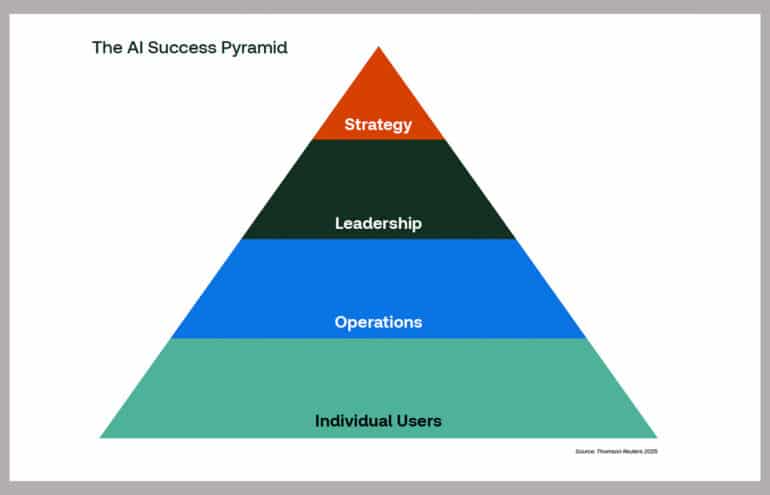
Strategy. The strongest lever of success is having an intentional versus ad hoc AI adoption strategy that aligns with the organization’s goals, respects the distinct needs of each team and each function within the organization and, ideally, is executed with precision across all levels.
Leadership. Transformation starts at the top. Organizations with leaders who lead by example when introducing change and are actively investing in AI are seeing more benefits than organizations that don’t. Forward-looking law firms are adding new roles like Chief Operations Officers and Chief Transformation Officers to their governance structures to align with AI-driven changes.
Operations. Firms that change how they deliver their services, adapt workflow and processes to maximize efficiency, rethink pricing models, and add new roles and skills will see more success. Approximately one-third of firms report increasing the proportion of work they do not bill by the hour.
People at the foundation. Firms that provide professionals with learning opportunities and room to improve will see greater ROI. The individual levers of success are: learning, empowerment (exploring new ways of working); ownership (input into policy), accountability (setting personal goals tied to AI), and consistent use.
The Modern Legal Professional
The report concludes with a section addressing the skills gap among modern professionals, along with ways firms can build more productive teams and ways individuals can improve their AI literacy. Professionals have made tremendous gains improving their AI skills over the past three reports. This year, “96% said they have at least a basic awareness of AI capabilities, although they also recognize their understanding still has room to develop.“
Active training, both online and in person, is the learning method most associated with higher levels of AI knowledge. The biggest predictor of success, however, is engaging in a wide variety of learning methods—reading, experimenting, participating in planning, and more formal training sessions—on both an organizational and personal level.
And, just like their firms, professionals who fail to develop a strategy for AI proficiency will struggle to remain relevant.
“As the demand for tech-savvy, adaptable and interdisciplinary collaboration continues to grow, those professionals not honing their skills in this way may find themselves adrift.”
Reaping AI’s Benefits
The bottom line: Law firms that craft a clear AI strategy — and move swiftly — will reap the benefits, as will professionals who proactively pursue AI proficiency.
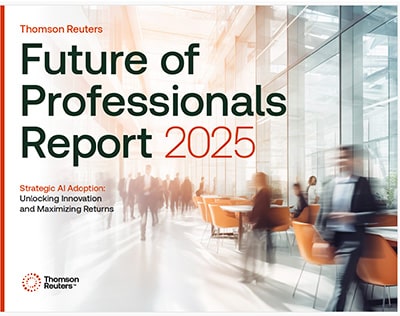
Strategic AI Adoption: Unlocking Innovation and Maximizing Returns
There is plenty more to absorb in the full 2025 Future of Professionals Report, available from Thomson Reuters.
Image © iStockPhoto.com.

Sign up for Attorney at Work’s daily practice tips newsletter here and subscribe to our podcast, Attorney at Work Today.











